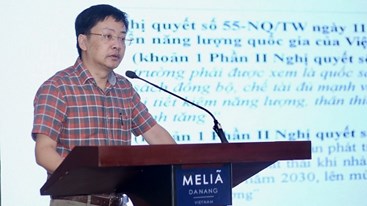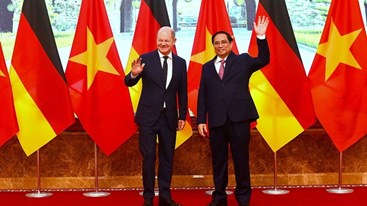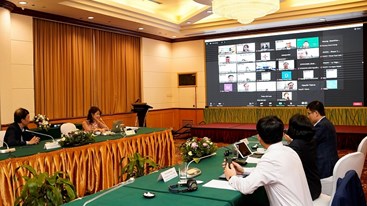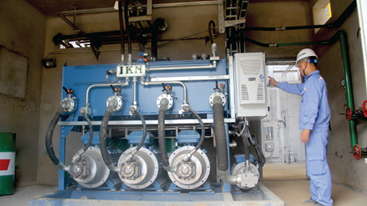As an agricultural country, Vietnam has great potential of biomass energy. Especially with vast rice fields, the Mekong Delta has abundant resources of rice husk and straw that can be used as types of biomass fuel. Unlike other renewable energies, biomass energy can replace fuel energy and help reduce environmental pollution. So biomass energy has close attachment with the low carbon economy that protects the ecosystem, promotes agricultural development, eliminates hunger and reduces poverty, greens the country and contributes to reducing damages caused by climate change.
Using gasification technology to bake products at the Tan Mai Company
According to the Energy Conservation Research and Development Center (ENERTEAM), when biomass fuel is heated the compositions are changed and transformed into gas. In the environment full of oxygen, this process is call gasification and in the environment without or little oxygen, it is called thermal degradation. Biomass fuel includes rice husk, straw, small pieces of wood and sawdust. By utilizing this cheap fuel resource, biomass technology produces gas without soot. When this fuel is burned, the fire is blue. This kind of energy is very useful and safe. According to statistics, a tonne of rice husk can produce an amount of energy equal to 378l oil and 415l gasoline. This amount of energy can meet the demand of a household for a year. Biomass energy can also be used in the trade sector such as drying coffee bean, tea, processing instant noodle and baking pottery products. Producing biomass fuel can become a support industry that creates jobs for people in rural areas and craft villages.
Dr. Phan Hieu Hien from the Ho Chi Minh City University of Agriculture and Forestry said that Vietnam has rich potential of biomass energy from rice husk, straw, wood and sugar-cane refuse. This type of fuel can be used to generate electricity, meet household demand and supply energy for large factories instead of coal, contributing to save energy and reducing environmental pollution. Therefore, it is necessary to enhance investment and apply advanced technology to exploit this type of energy. Some models of exploiting biomass energy have been implemented in the provinces of Dong Thap, An Giang and Vinh Long.
Ngo Doan Luat, the director of the Tan Mai Ceramic Company Limited, said that the four room brick furnace that use gasification technology from straw and inverter technology has helped the company reduce electricity consumption, recycle water and reduce waste. In addition, this kind of brick furnace produces higher quality products with lower percentage of waste. A majority of waste is produced when materials are put in the furnace or when products are taken out of the furnace. Baking phase produces little waste. By utilizing heat, it takes just eight hours for the four room brick furnace to produce bricks or baked decorative products. Meanwhile, it takes traditional brick furnaces 40 days to produce a batch of products. The productivity of this technology is 10 times more than traditional furnace. Thanks to this technology, the company can reduce space that is used to store raw materials. In addition, in rainy season, this technology helps the company to dry materials effectively. Ngo Doan Luat said that this technology saves nearly 63 percent of fuel. Although the investment capital to buy gasification equipment is rather large, this equipment helps the company to save production costs, enhance labor capacity and increase worker's income. According to experts, waste from gasification technology does not pollute the environment.
ENERTEAM has introduced some cheap models of green brick furnace that use gasification technology in the Mekong Delta. Compared to traditional technology, those models help save 20 percent of fuel. Investment capital will be paid back within 1-3 years. Those models have received special attention of people.
With abundant resources of biomass fuel, Vietnam has rich potential of this energy. By applying advanced technology to exploit this type of energy, businesses will have opportunities to raise economic efficiency, lower energy consumption, reduce environmental pollution and strengthen competitiveness.
By Le My






.png?w=367&h=206&mode=crop)
.jpg?w=367&h=206&mode=crop)

.jpg?w=367&h=206&mode=crop) Notice for Contracts award for Support to Industrial Enterprises for Energy Audits and Preparation of Feasibility Studies (Package No. C2.2.4)
04/06/2024
Notice for Contracts award for Support to Industrial Enterprises for Energy Audits and Preparation of Feasibility Studies (Package No. C2.2.4)
04/06/2024
 Training Courses for Energy Managers and Energy Auditors
Training Courses for Energy Managers and Energy Auditors
 Vietnam Energy Outlook Report – Pathway to Net Zero
Vietnam Energy Outlook Report – Pathway to Net Zero
 Long Son Cement saves 30% of electricity consumption thanks to heat recovery
Long Son Cement saves 30% of electricity consumption thanks to heat recovery
 Expression of Interest: C2.1.15: Development of Energy-Efficient Technology Catalogs for the Industrial Sector
Expression of Interest: C2.1.15: Development of Energy-Efficient Technology Catalogs for the Industrial Sector
 Optimizing Compressed Air Systems for Southern Industrial Enterprises
Optimizing Compressed Air Systems for Southern Industrial Enterprises
 The Ministry of Industry and Trade Review the Energy Efficiency and Conservation activities in Lao Cai.
The Ministry of Industry and Trade Review the Energy Efficiency and Conservation activities in Lao Cai.
 EOI Extension: C2.2.2: Review and update for current EE benchmarking for 2 sub-industrial sectors
EOI Extension: C2.2.2: Review and update for current EE benchmarking for 2 sub-industrial sectors